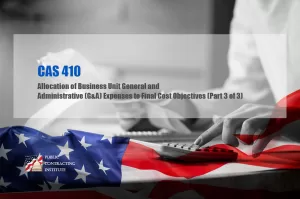*This is Part 3 of a 3-part blog. Each part addresses the fundamental requirements and techniques for application related to the standard, and provides specific examples.
- This Part 3 addresses special allocations of G&A expenses.
Background: To provide criteria for the allocation of business unit general and administrative (G&A) expenses to business unit final cost objectives. The standard also provides criteria for allocating home office expenses received by the business unit segment to business unit final cost objectives (CAS 410-20).
G&A Special Allocations
- CAS 410-40(b)(2) states that the allocation of the G&A expense pool to any particular final cost objectives which receive benefits significantly different from the benefits accruing to other final cost objectives shall be determined by special allocation. In addition, 410-50(j) states that where a particular final cost objective in relation to other final cost objectives receives significantly more or less benefit from G&A expense than would be reflected by an allocation using a base required by CAS 410, a special allocation of G&A expense shall be used for that cost objective.
EXAMPLE: A contractor business unit has $1 billion in sales and 150 contracts. The contractor uses a total cost input base that complies with the requirements of CAS 410. On January 1, 2014, the contractor is awarded a $500 million contract. The contract requires the contractor to supply a large amount of equipment, which will constitute $350 million of the total contract cost. The contractor does not normally supply this type of equipment when it performs contract work, and plans to lease the equipment. The Government and the contractor enter into an advance agreement that provides for a special allocation of G&A costs to the $500 million contract. This is in accordance with CAS 410, since inclusion of the total cost input for this single final cost objective would result in the contract receiving a disproportionate allocation of G&A.
- CAS 410-50(j) requires that when a special allocation is used, the amount of the special allocation must be excluded from the G&A expense pool and the cost input of the final cost objective receiving the special allocation must be removed from the G&A allocation base.
EXAMPLE: The Government and the contractor agree that a special allocation is appropriate for Contract J. The Government and contractor agree that the special allocation for FY 2014 is $100,000. The contractor uses a total cost input allocation base for G&A. During FY 2014, the total G&A expense was $800,000. The total cost input, including Contract J, was $10,000,000. The total cost input for Contract J was $3,000,000. In accordance with CAS 410, the contractor computes its G&A rate as follows:
| Item | G&A Expense | G&A Allocation Base |
| Total | $800,000 | $10,000,000 |
| Less: Contract J | $100,000 | $ 3,000,000 |
| Net | $700,000 | $ 7,000,000 |
Thus, the G&A rate used for purposes of applying G&A expenses to contracts other than Contract J is 10% ($700,000/$7,000,000).



